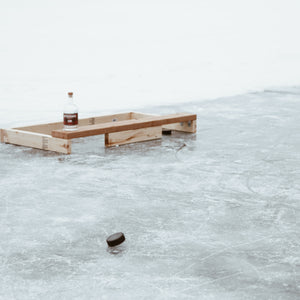At Third Assist we're going to start a limited series sharing the history of some of the most common hockey equipment found in today's game. We're starting with the hockey puck. No one puts much thought into the hockey puck until you realized how far its come.

The Wood Hockey Puck
The use of a wooden puck in hockey has a long history. It is believed that the first hockey puck was made of wood and was used in the early 19th century in Windsor, Nova Scotia, Canada, where a group of British soldiers played a game similar to field hockey on a frozen pond. The soldiers used a small, round piece of wood or maybe even a ball of frozen cow dung as a puck.
As the game of hockey spread throughout Canada, the wooden puck continued to be used, but it had its limitations. Wood is a brittle material and could break or shatter upon impact, which made it less durable than other materials. In the late 1800s, rubber pucks were introduced, which were more durable and could be shot with more force. In the early 1900s, the first vulcanized rubber pucks were used in professional games, and these pucks are still used today in most levels of hockey (see below).
The first professional hockey game which took place in Montreal in 1875 used a wood hockey puck. While wooden pucks are no longer used in professional hockey, they are still used in some recreational and amateur leagues, as well as in historical reenactments of the game. Some players and collectors also appreciate the nostalgia and craftsmanship of wooden pucks, which can be made by hand using traditional woodworking techniques.

At Third Assist one of the entertaining projects we've been working on is creating and sharing the wood hockey puck with our community. In the 2022 season we started sharing a wood puck free with most purchases. It's not something we heavily advertised, but we thought it would be fun to get the wood puck back on some ponds, driveways, and may even a modern rink.
Our takeaway on the wood puck? It's way lighter than one might think and we could absolutely see it taking some abuse hitting the cold iron of a modern net. However the unique wood slide and added unpredictability makes it well worth taking for a spin.

The Rubber Hockey Puck
The first vulcanized rubber pucks were used in professional hockey in the early 1900s, and these pucks are still used today in most levels of hockey. Vulcanized rubber is a type of rubber that has been treated with heat and chemicals to make it more durable and resilient. This process gives the puck a more consistent bounce and makes it less prone to damage.
Today, the hockey puck is an integral part of the game, and it is used to score goals by shooting it into the opposing team's net, as well as to pass the puck between players. It is made of vulcanized rubber and is circular in shape, with a diameter of about three inches and a thickness of about one inch. It is often frozen before each professional game to make it harder and more durable.

Did you know that the NHL didn't require regulation puck specifications until the 1990s? All pucks were similar but didn't have to be the same until the 1990 season. You can find modern puck manufacturers in all of the following countries: Canada, Czech Republic, China, Slovakia, and the United States.
Keep an eye out as we share more history on the equipment of the past and how it's evolved into our equipment today.




